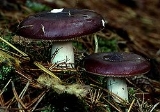
Russula caerulea
Encyclopedia
Russula caerulea, commonly known as the humpback brittlegill, is a member of the Russula
genus, whose members are also known as brittlegills. It is a dark vinaceous or purple-colored edible
mushroom, and grows with coniferous trees in late summer and autumn. It is found in Europe and North America.
in his 1801 work Synopsis methodica fungorum as Agaricus caeruleus, its specific epithet is the Latin
caeruleus meaning "blue". It was transferred to the genus Russula in 1838 by the Swedish father of mycology Elias Magnus Fries
. The 1927 name Russula amara by Kučera is a synonym.
is 3–10 cm (1.2–4 in) in diameter. It is dark purplish-brown, with a dark, sometimes almost black centre. At first it is convex, or even nearly bell-shaped, but later flattens. It nearly always retains a broad pointed boss (umbo) in the cap centre which is a profile that is almost unique within the genus
. The cap skin peels to two-thirds, and it later has a furrowed margin. The firm, white stipe
is 4–9 cm (1.6–3.6 in) high, 1–2 cm (0.4–0.8 in) wide and narrowly club-shaped. The gills are adnexed to almost free, and are pale ochre, giving a spore print
of the same colour. They are quite closely spaced initially. The flesh is white and tastes mild, but the cap skin is bitter on the tongue.
) Britzelm is infrequent with conifers, preferring deciduous woods, and forests. Its cap is never umbonate, but usually depressed.
Russula viscida Kudrna has no umbo either, and is very rare. The cuticle of the cap hardly peels at all.
zones, Europe, Asia, and North America. It is probably mycorrhizal with pine trees (Pinus), on sandy soils.
Russula
Around 750 worldwide species of mycorrhizal mushrooms compose the genus Russula. They are typically common, fairly large, and brightly colored - making them one of the most recognizable genera among mycologists and mushroom collectors...
genus, whose members are also known as brittlegills. It is a dark vinaceous or purple-colored edible
Edible mushroom
Edible mushrooms are the fleshy and edible fruiting bodies of several species of fungi. Mushrooms belong to the macrofungi, because their fruiting structures are large enough to be seen with the naked eye. They can appear either below ground or above ground where they may be picked by hand...
mushroom, and grows with coniferous trees in late summer and autumn. It is found in Europe and North America.
Taxonomy
First described by mycologist Christian Hendrik PersoonChristian Hendrik Persoon
Christiaan Hendrik Persoon was a mycologist who made additions to Linnaeus' mushroom taxonomy.-Early life:...
in his 1801 work Synopsis methodica fungorum as Agaricus caeruleus, its specific epithet is the Latin
Latin
Latin is an Italic language originally spoken in Latium and Ancient Rome. It, along with most European languages, is a descendant of the ancient Proto-Indo-European language. Although it is considered a dead language, a number of scholars and members of the Christian clergy speak it fluently, and...
caeruleus meaning "blue". It was transferred to the genus Russula in 1838 by the Swedish father of mycology Elias Magnus Fries
Elias Magnus Fries
-External links:*, Authors of fungal names, Mushroom, the Journal of Wild Mushrooming.*...
. The 1927 name Russula amara by Kučera is a synonym.
Description
The capPileus (mycology)
The pileus is the technical name for the cap, or cap-like part, of a basidiocarp or ascocarp that supports a spore-bearing surface, the hymenium. The hymenium may consist of lamellae, tubes, or teeth, on the underside of the pileus...
is 3–10 cm (1.2–4 in) in diameter. It is dark purplish-brown, with a dark, sometimes almost black centre. At first it is convex, or even nearly bell-shaped, but later flattens. It nearly always retains a broad pointed boss (umbo) in the cap centre which is a profile that is almost unique within the genus
Genus
In biology, a genus is a low-level taxonomic rank used in the biological classification of living and fossil organisms, which is an example of definition by genus and differentia...
. The cap skin peels to two-thirds, and it later has a furrowed margin. The firm, white stipe
Stipe (mycology)
thumb|150px|right|Diagram of a [[basidiomycete]] stipe with an [[annulus |annulus]] and [[volva |volva]]In mycology a stipe refers to the stem or stalk-like feature supporting the cap of a mushroom. Like all tissues of the mushroom other than the hymenium, the stipe is composed of sterile hyphal...
is 4–9 cm (1.6–3.6 in) high, 1–2 cm (0.4–0.8 in) wide and narrowly club-shaped. The gills are adnexed to almost free, and are pale ochre, giving a spore print
Spore print
thumb|300px|right|Making a spore print of the mushroom Volvariella volvacea shown in composite: mushroom cap laid on white and dark paper; cap removed after 24 hours showing pinkish-tan spore print...
of the same colour. They are quite closely spaced initially. The flesh is white and tastes mild, but the cap skin is bitter on the tongue.
Similar species
Russula atropurpurea (Krombh.Julius Vincenz von Krombholz
Julius Vincenz von Krombholz was a physician and mycologist born in Oberpolitz , northern Bohemia....
) Britzelm is infrequent with conifers, preferring deciduous woods, and forests. Its cap is never umbonate, but usually depressed.
Russula viscida Kudrna has no umbo either, and is very rare. The cuticle of the cap hardly peels at all.
Distribution and habitat
Russula caerulea appears in late summer and autumn. It is widespread in the northern temperateTemperate
In geography, temperate or tepid latitudes of the globe lie between the tropics and the polar circles. The changes in these regions between summer and winter are generally relatively moderate, rather than extreme hot or cold...
zones, Europe, Asia, and North America. It is probably mycorrhizal with pine trees (Pinus), on sandy soils.

